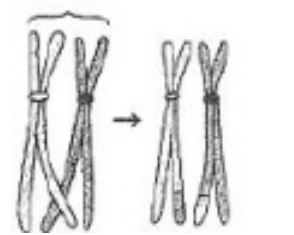Cell Cycle and Cell Division
- Lampbrush chromosomes occur during
-
View Hint View Answer Discuss in Forum
Lampbrush chromosomes are highly elongated bivalent chromosomes of diplotene stage, which are held together by chiasmata and have a large number of lateral loops for rapid transcription.
Correct Option: B
Lampbrush chromosomes are highly elongated bivalent chromosomes of diplotene stage, which are held together by chiasmata and have a large number of lateral loops for rapid transcription.
- The exchange of genetic material between chromatids of paired homologous chromosomes during first meiotic division is called
-
View Hint View Answer Discuss in Forum
The points of attachment between homologous chromosomes after their separation in diplotene are called chiasmata. The process of pairing of homologous chromosomes is called synapsis. The phenomenon by which DNA isolated from one type of cell, when introduced into another type, is able to bestow some of the properties of the former to the latter, is known as transformation.
Correct Option: C
The points of attachment between homologous chromosomes after their separation in diplotene are called chiasmata. The process of pairing of homologous chromosomes is called synapsis. The phenomenon by which DNA isolated from one type of cell, when introduced into another type, is able to bestow some of the properties of the former to the latter, is known as transformation.
- Genetic map is one that
-
View Hint View Answer Discuss in Forum
Genetic mapping help in studying the architecture of the chromosomes and of entire genome.
Correct Option: B
Genetic mapping help in studying the architecture of the chromosomes and of entire genome.
- Identify the meiotic stage in which the homologous chromosomes separate while the sister chromatids remain associated at their centromeres?
-
View Hint View Answer Discuss in Forum
Anaphase I begins when the two chromosomes of each bivalent (tetrad) separate and start moving toward opposite poles of the cell as a result of the action of the spindle. In anaphase I, the sister chromatids remain attached at their centromeres and move together toward the poles.
Correct Option: C
Anaphase I begins when the two chromosomes of each bivalent (tetrad) separate and start moving toward opposite poles of the cell as a result of the action of the spindle. In anaphase I, the sister chromatids remain attached at their centromeres and move together toward the poles.
- Given below is the representation of a certain event at a particular stage of a type of cell division. Which is this stage?

-
View Hint View Answer Discuss in Forum
The given diagram represents crossing over that takes place in pachytene stage of prophase - I during meiosis.
Correct Option: A
The given diagram represents crossing over that takes place in pachytene stage of prophase - I during meiosis.

